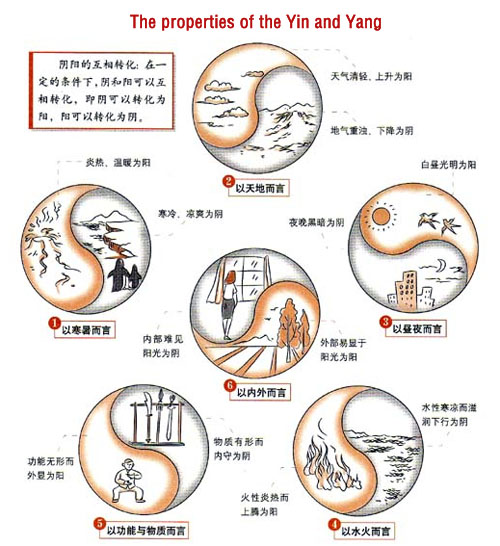When the balance between yin and yang in the body is damaged, it leads to various diseases known as "imbalance between yin and yang". Though complicated, pathological changes generally fall into two categories, relative predominance of yin or yang and relative decline of yin or yang, according to the .analysis of pathogenesis with the theory of yin and yang.
Relative Predominance of Yin or Yang
Relative predominance of yin and yang, a pathological change due to excessive increase of yin and yang, includes two aspects: relative predominance of yin and relative predominance of yang. Yin or yang that becomes predominant inevitably turns into a pathogenic factor. So predominant yin becomes a pathogenic factor of yin nature and predominant yang a pathogenic factor of yang nature.
Relative predominance of yang, usually caused by invasion of pathogenic factors of yang nature or exuberant heat transforming from the pathogenic factors of yin nature activated by yang, is a manifestation of excess-heat syndrome known as "predominance of yang leading to heat" in Huangdi Neijing. Pathogenic factors of different nature impair the corresponding healthy qi in the body. So pathogenic factors of yang nature tends to consumption of yin-fluid in the course of pathological changes.
That is why it is said in Huangdi Neijing that "predominance of yang leading to disease of yin." "Disease" here means impairment. For example, invasion of pathogenic heat into the body will make yang-qi in the body hyperactive, leading to high fever, sweating, reddish complexion and rapid pulse. With the progress of the morbid condition, pathogenic factors of yang nature consume yin-fluid in the body, bringing on thirst, scanty urine and constipation.

Relative predominance of yin is usually caused by invasion of pathogenic factors of yin nature into the body, leading to exuberance of yin-cold and bringing on excess cold syndrome known as "predominance of yin leading to cold" in Huangdi Neijing. If pathogenic factors of yin nature further impair yang-qi in the body, a pathogenesis of "predominance of yin leading to disease of yang" will arise, as is recorded in Huangdi Neijing. Take pathogenic cold for example. When it invades the body, it leads to cold symptoms like aversion to cold, cold limbs and cold abdominal pain on the one hand, and symptoms due to yang-deficiency like floating whitish complexion, lassitude, frequent lying on bed, slow and weak pulse on the other hand.
Besides, when relative predominance of yin or yang develops to the extreme point, mutual transformation will occur under certain condition according to the principle of inter-transformation between yin and yang. That is to say that yin-cold syndrome will turn into yang-heat syndrome and vice versa.
Relative Decline of Yin or Yang
Relative decline of yin or yang refers to pathological changes of yin or yang that declines below the normal level, including relative decline of yin and relative decline of yang. This morbid state mainly results from insufficiency of healthy qi in the body. To be specific, relative decline of yin refers to insufficiency of yin-fluid and relative decline of yang to insufficiency of yang-qi in the body. Usually relative decline of yin or yang leads to the imbalance between yin and yang which brings on hypofunction of the viscera.
Relative decline of yang refers to deficiency-cold syndrome due to insufficiency of yang-qi that fails to restrain yin-cold and warm the viscera. The usual clinical symptoms are whitish complexion, aversion to cold, spontaneous sweating, slow and weak pulse. This morbid state was described as "deficiency of yang leading to cold" in Huangdi Neijing.
Relative decline of yin refers to deficiency-heat syndrome due to insufficiency of yin-fluid that fails to restrain yang-heat and nourish the viscera. The usual clinical symptoms are reddish complexion, tidal fever, night sweating, thin and rapid pulse. This morbid state was described as "deficiency of yin leading to heat" in Huangdi Neijing.
Since yin and yang depend on each other and no one can exist without the other, relative decline of yin or yang may affect each other with the development of pathological changes. That is to say that prolonged deficiency of yin will lead to deficiency of yang and protracted deficiency of yang will bring on insufficiency of yin-fluid, eventually resulting in deficiency of both yin and yang.
When relative predominance of yin or yang and relative decline of yin or yang become extremely serious, it will lead to declination of healthy qi and bring on special changes of pathogenesis known as "loss of yin" and "loss of yang" which consequently cause death due to separation of yin and yang.







